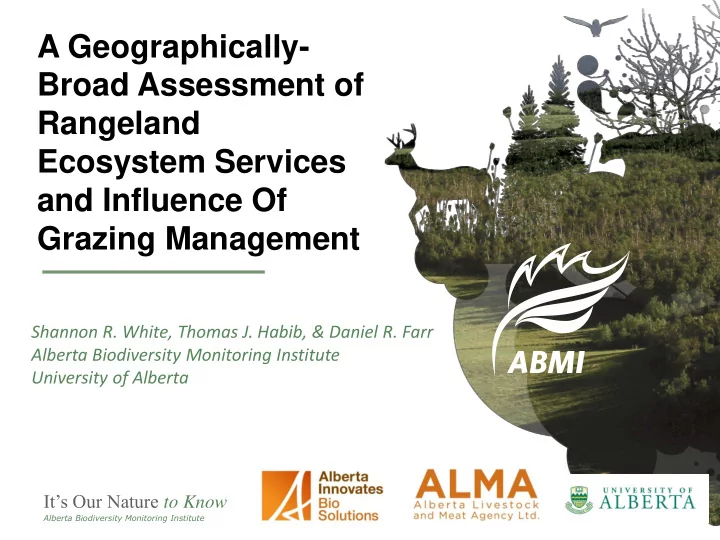

A Geographically- Broad Assessment of Rangeland Ecosystem Services and Influence Of Grazing Management Shannon R. White, Thomas J. Habib, & Daniel R. Farr Alberta Biodiversity Monitoring Institute University of Alberta It’s Our Nature to Know Alberta Biodiversity Monitoring Institute
Alberta Mean Annual Precipitation 300 - 600 mm Mean Annual Temperature ~2 ° C (36 ° F) Area 661,848 km 2
• Substantial remnant prairie • Cattle grazing is predominant use • Provides ecosystem services
Rangelands provide all these services (and more)
• Conversion continues • Current market doesn’t account for ecosystem services • New markets for ranchers?
• Less than half of rangeland in “good” condition (Prairie Agricultural Landscapes, AAFC) • Potential to improve rangeland management • Especially if there is incentive
Value?
• Develop detailed, spatially-explicit models to measure and map focal ecosystem services across Alberta , and assess how they change with land management
• Part of a province-wide initiative • Further incorporate this knowledge into market-based instruments
Forage production Carbon storage As well as pollination, water purification, biodiversity, timber production “Beta release” March 2014 Open source; open data
1. Modeling platform • Soil carbon • Grass/Crop • Water, N, P • Management and events (Parton et al., 1998)
1. Modeling platform: CENTURY model 2. Study extent: Agricultural region of AB
1. Modeling platform: Century model 2. Study extent: Agricultural region of AB 3. Soil, climate & land cover/use data for each polygon 4. Run model for each soil polygon, using i-Century (CARD, 2013)
1. Modeling platform: Century model 2. Study extent: Agricultural region of AB 3. Soil, climate & land cover/use data for each polygon 4. Run model for each soil polygon, using i-Century (CARD, 2013) 5. Extract for native grassland
Century is well used model – Validation needed R 2 = 0.61 p < .001 Modeled aboveground production (kg/ha)
What questions can we ask? • Value over large spatial extent • Effect of land use/management – Conversion between prairie and cropland – Grazing intensity • Trade-offs • Climate change
What about modifying grazing intensity?
Mean = Mean = 26 tC/ha 35 tC/ha
$15/ton CO 2 Mean = Mean = 26 tC/ha 35 tC/ha
=$ 1.8 billion additional carbon storage
Applications • Scorecards – For a region, or industry • Scenario modelling • Informing policy • Market-based instruments – i.e. Conservation offsets, payment for ecosystem services
Carbon credits for grassland >4X C in soil than atmosphere
Carbon credits for grassland Accounting based off Century model
Funders: Collaborators: Thank you:
shannon.white@ualberta.ca More info: http://www.ecosystemservices.abmi.ca/
Recommend
More recommend